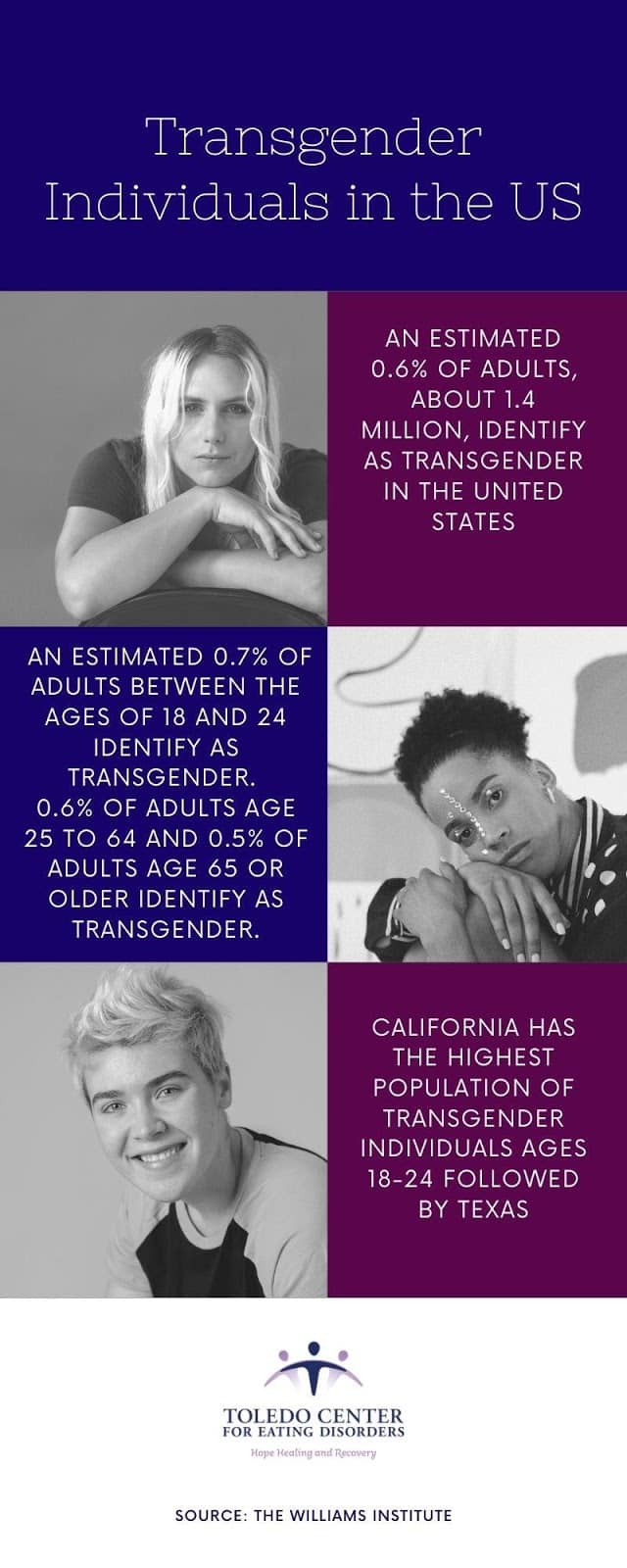How Eating Disorders Affect Transgender Youth
According to a 2016 analysis by The Williams Institute, roughly 1.4 million people in the United States identify as transgender. Typically, most people begin developing their gender identity as early as two years old. For most, their gender identity aligns with the sex in which they were born. However, transgender youth often find themselves struggling with their identity and being comfortable with their bodies, stirring up emotions such as depression, anxiety, and even guilt. Along with these emotions, research has shown that transgender youth are at greater risk for developing an eating disorder such as anorexia or bulimia.
The Journal of Adolescent Health found that college-aged individuals were more than four times likely than cisgender female college students to have an eating disorder, and twice as likely to engage in purging behaviors. Of the 30,000 transgender college students sampled, 13.5% reported using diet pills, and 15% reported vomiting or using laxatives within the past month of being surveyed. Additionally, the survey found high school-aged transgender students were three times as likely to restrict calories, and seven times as likely to use laxatives to control their weight.
How transgender is defined?
The American Psychological Association defines transgender as “persons whose gender identity, gender expression or behavior does not conform to that typically associated with the sex to which they were assigned at birth.” Gender identity refers to “a person’s internal sense of being male, female, or something else.” The language around those who identify as transgender is constantly changing with the consistent need for compassion, openness, acceptance, and knowledge.

Why are transgender youth at risk for an eating disorder?
Although our society is becoming more accepting of those who identify as transgender, we must continue to recognize the stigma and discrimination still being faced today because of gender identity. Transgender youth tend to experience high levels of distress about the gender roles they are expected to follow, along with challenges in social interactions, often causing increased anxiety, depression, and in some cases eating disorder behavior. Studies have found transgender youth who have frequently been harassed or discriminated against are more likely to have eating disorder symptoms. Additionally, the increase in healthcare barriers experienced by transgender youth can potentially increase body dissatisfaction and eating disorder risks. Many transgender youths have reported experiencing negative encounters with healthcare providers, while, those who have had positive medical interventions have decreased eating disorder symptoms and higher body satisfaction.
The Journal of Adolescent Health cites body dissatisfaction as one of the main reasons why transgender youth develop an eating disorder. While some people will use surgery or hormone replacement therapy to change their bodies, others may use dieting, exercise, and methods of purging. Often, these choices lead to unhealthy, disordered behaviors as they try to achieve their ideal body.
What are the signs and symptoms of an eating disorder?
The chance for recovery increases when an eating disorder is detected early. To help their child, parents of transgender youth should be aware of the common signs and symptoms of an eating disorder as noted by the National Eating Disorder Association.
Emotional and behavioral
- Change in behaviors and attitudes that indicate that weight loss, dieting, and control of food are becoming primary concerns
- Preoccupation with weight, food, calories, carbohydrates, fat grams, and dieting
- Refusal to eat certain foods, progressing to restrictions against whole categories of
- Appears uncomfortable eating around others
- Development of food rituals
- Skipping meals or taking small portions of food at regular meals
- Any new practices with food or fad diets, including cutting out entire food groups
- Withdrawal from usual friends and activities
- Frequent dieting
- Extreme concern with body size and shape
- Frequent checking in the mirror for perceived flaws in appearance
- Extreme mood swings
Physical
- Noticeable fluctuations in weight, both up and down
- Stomach cramps, other non-specific gastrointestinal complaints (constipation, acid reflux, etc.)
- Menstrual irregularities
- Difficulties concentrating
- Abnormal laboratory findings (anemia, low thyroid and hormone levels, low potassium, low white and red blood cell counts)
- Dizziness, especially upon standing
- Fainting/syncope
- Feeling cold a majority of the time
- Sleep problems
- Cuts and calluses across the top of finger joints (a result of inducing vomiting)
- Dental problems, such as enamel erosion, cavities, and tooth sensitivity
- Dry skin and hair, and brittle nails
- Swelling around the area of salivary glands
- Fine hair on the body (lanugo)
- Cavities, or discoloration of teeth, from vomiting
- Muscle weakness
- Yellow skin (in the context of eating large amounts of carrots)
- Cold, mottled hands and feet or swelling of feet
- Poor wound healing
- Impaired immune functioning
What help is available?
At Toledo Center, we provide treatment that meets the specific challenges of transgender youth suffering from eating disorders. We understand the need to respect their gender identity and develop a treatment plan that helps them sustain recovery. Our Adolescent Residential program offers medical and psychiatric supervision, utilizing evidence-based clinical interventions to help process underlying issues related to eating disorders. We place an emphasis on meal planning, symptom reduction and elimination skills, and relapse prevention in individual, group, and family sessions. Transgender youth face unique challenges, and for that reason, Toledo Center promotes positive wellbeing that can help them develop emotional skills, social skills, assertiveness, and stress management techniques that contribute to recovery from an eating disorder.
If you would like more information about eating disorder treatment in an inclusive, safe, and comfortable environment, contact us today. We strive to help youth restore their physical and psychological well-being as they transition to a life of freedom from eating disorders.

